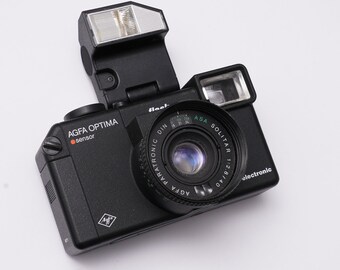
#Agfa optima sensor flash iso
Lens: 40 mm f/2.8 Agfa Paratronic Solitar (4 elements, 3 groups).Įxposure meter: Single CdS cell located above front lens element.įilm Speed Range:ISO 25 (DIN 15) to ISO 500 (DIN 28).įilm Advance: Single-stroke, Built-in double exposure and double winding prevention.įilter Thread: 49mm – filter covers metering cell, no adjustment needed.Īll my images on Flickr using the Optima Flash Sensor.
#Agfa optima sensor flash full
GalleryĬamera Type: 35mm full frame camera with EE aperture control, automatic mode (2 bladed leaf shutter). Similarly to avoid bleaching out a sky you could increase the ISO, forcing a faster shutter speed possibly creating a silhouette. Using the ISO selector gives you a limited level of exposure compensation – for example in a bright backlit subject you could decrease the ISO to fool a longer shutter speed and ensure the subject is better exposed. You would of course not be able to use this in situations where the lighting was brighter, as you would over expose one stop – but this is often fine on negative film.

From tests I think that it will just default to it’s best exposure if the light is too low, rather than refusing to take a shot, so you could use ISO 800 film to get a better exposure in these conditions. So in low light you could just use higher ISO rated film.

Setting the ISO selector controls the meter. I have read, though not confirmed through a validated source, that the minimum aperture is f/22 – This will handle any natural light you could throw at it. With ISO 200 film you are looking at EV 8 (city centre squares, floodlit stadiums, brightly lit interiors with fluorescent lighting), with ISO 100 EV 9 (landscapes 10 minutes after sunset, spotlit subjects), with ISO 50 this is EV 10 (landscapes immediately after sunset), with ISO 25 this is EV 11 (sunset, subjects in deep shade). This camera does some nice stuff in low light. You could use this is a well lit club without a flash, just. With the highest native ISO setting if 500 this is about EV 6, but you don’t tend to find ISO 500 film nowadays. The longest exposure is 1/45s and the fastest aperture is f/2.8, at ISO 400 this gives an EV of between 6 (brightly lighted home interiors, amusement parks) and 7 (Brightly lighted night-time streets, stage shows). ISO is set by a dial on the front of the lens barrel, also on the front here is the light sensor, which means you can attach a filter to the 49mm thread and meter as normal. It does not make sense to produce an exposure table for this reason, but some tips and tricks can be used.

The exposure is shutter priority program AE – this means that both the shutter and aperture are set by the camera, favouring a faster shutter speed. The shutter is an electronically controlled 2 bladed leaf shutter. The focusing is a continuous zone focus system, with guide indicator symbols for single person, groups and landscapes on one side of the lens barrel, and a distance scale on the other. This gives a field of view of 48° x 33°, standing about 3m away will you allow for a full body portrait. The lens is 40mm, and pretty sharp with its 4 elements in 3 groups. I am not fully clear how engaging the flash affects the exposure program. It has a fairly large, blocky, pop-up flash with a guide number of 12. The second is a plate that snaps down over the receiving reel, protecting exposed frames if the back is accidentally opened.

There are two particularly interesting features – the first being that to rewind the film you need to engage the rewind button and then continue using the film winder.


 0 kommentar(er)
0 kommentar(er)
